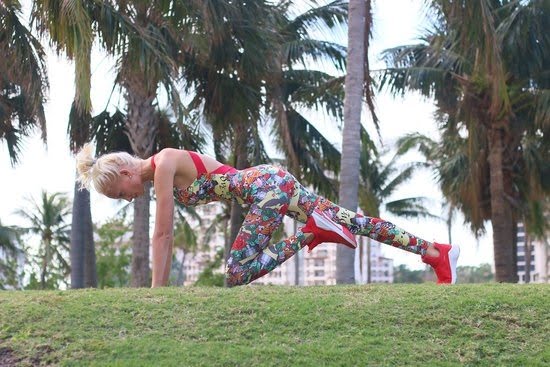Capoeira, a Brazilian martial art and dance form, offers a wide range of fitness benefits for both the body and mind. This captivating combination of fluid movements, acrobatics, and rhythmic music not only provides a unique cultural experience but also promotes physicality and overall well-being.
Originating in the 16th century as a form of self-defense among African slaves in Brazil, Capoeira has evolved into a dynamic art form that blends elements of dance, music, acrobatics, and martial arts. It combines fast-paced kicks, spins, flips, and sweeps with graceful flowing movements that challenge and engage the entire body.
One of the key aspects that sets Capoeira apart from other forms of exercise is its ability to build strength, flexibility, and cardiovascular fitness. The constant movement patterns require participants to develop core strength while simultaneously engaging muscles throughout the entire body. Additionally, the acrobatic elements of Capoeira provide an excellent opportunity for building muscular endurance as practitioners perform impressive moves such as handstands and cartwheels.
In addition to physical fitness benefits, Capoeira also offers mental benefits by enhancing mental focus, discipline, and self-confidence. The intricate coordination required to execute complex movements cultivates concentration skills while developing adaptability and quick thinking. Moreover, the rhythmic music played during Capoeira sessions creates an energizing atmosphere that uplifts mood and encourages positive mental health.
As we delve further into the world of Capoeira’s unique fitness benefits in this article, we will explore how it strengthens core muscles through dynamic movements. We will also discuss how balance and coordination are essential components of this practice that contribute to overall fitness levels.
Furthermore, we will uncover how Capoeira fosters a sense of community and inclusivity while aiding in injury prevention and promoting physical rehabilitation. So join us on this journey through the different dimensions of Capoeira’s fitness advantages and discover why it is a form of exercise worth trying.
History of Capoeira
Capoeira is a unique Brazilian martial art and dance form that originated in the 16th century. Its roots can be traced back to the African slaves who were brought to Brazil during the colonial era. These slaves, who were forced to work on sugarcane plantations, developed Capoeira as a means of self-defense and resistance against their oppressors.
The Origins of Capoeira
Capoeira was born out of necessity and served as a way for the slaves to defend themselves while disguising their training as a form of celebration or dance. Due to the harsh conditions and constant surveillance they faced, the slaves had to find creative ways to practice their fighting techniques without attracting attention. Thus, Capoeira became a blend of martial arts moves, acrobatics, music, and dance – all performed in a fluid and rhythmic manner.
Evolution and Cultural Integration
As time went on, Capoeira started to evolve and adapt by drawing influences from various cultures including Indigenous Brazilian tribes, European settlers, and even other African martial arts. It became an integral part of Afro-Brazilian communities, serving not only as a means of physical training but also as a form of cultural expression and identity.
In the early 20th century, with slavery abolished in Brazil, Capoeira gained more recognition and began to be practiced openly. However, it still faced discrimination and legal restrictions due to its association with marginalized communities. In order to gain wider acceptance, Capoeira was eventually codified into different styles with standardized movements and rules.
Today, Capoeira is celebrated worldwide as an important cultural heritage of Brazil. It continues to preserve its historical roots while embracing innovation through modern interpretations and adaptations. Whether seen as an art form or a martial art discipline, Capoeira’s rich history adds depth and context to its unique fitness benefits.
Capoeira’s Unique Fitness Benefits
Capoeira is not just a martial art and dance form; it also offers unique fitness benefits that promote physicality and overall well-being. Through its dynamic movements, Capoeira engages the entire body, building strength, flexibility, cardiovascular fitness, and core muscles.
One of the key fitness benefits of Capoeira is its effectiveness in strength and endurance training. The constant movement and acrobatic elements in Capoeira require participants to engage their muscles fully, resulting in increased strength and muscle tone. Additionally, the fast-paced nature of Capoeira enhances cardiovascular endurance, improving overall stamina and lung capacity.
Capoeira also places a strong emphasis on core strengthening. The fluid and rotational movements in this martial art specifically target the core muscles, including the abdominals, obliques, and lower back. As a result, practitioners develop strong and stable cores that contribute to better posture, balance, and overall body control.
Moreover, Capoeira greatly enhances balance and coordination skills. The intricate footwork combined with flips, kicks, and spins require participants to maintain equilibrium while executing complex movements. Practicing Capoeira consistently trains proprioception (the sense of body awareness) as well as coordination between different muscle groups. These skills are transferable to other sports or activities that demand agility and precise movements.
In summary, Capoeira offers unique fitness benefits that enhance physicality and overall well-being. Through strength and endurance training methods incorporated into this martial art form, individuals can improve muscular strength as well as cardiovascular endurance. Additionally, the focus on core strengthening contributes to better stability and body control. Lastly,.
the emphasis on balance
and coordination
adds another layer
of benefit for practitioners.
Overall,
Capoeira provides a holistic approach to fitness,
engaging both
the mind
and body
to achieve optimal health.
Joining a capoeira class can be an exciting way
to experience
these unique
fitness benefits
while being part of a supportive and inclusive community. Whether you are looking to improve your physical fitness, mental focus, or become more connected with the cultural roots of Brazil, Capoeira has something to offer for everyone.
Strength and Endurance Training
Capoeira is not just a form of martial art and dance, but it is also an intense workout that offers numerous fitness benefits. One of the key aspects of Capoeira is its focus on strength and endurance training, which helps individuals improve their overall physical fitness.
Firstly, Capoeira builds strength by engaging various muscle groups throughout the body. The constant movements in Capoeira, such as kicks, sweeps, and acrobatic maneuvers, require significant muscular effort. As a result, practitioners develop stronger muscles in their legs, arms, and core. These movements also enhance flexibility as they require participants to stretch and extend their limbs to perform various kicks and aerial tricks.
In addition to building strength and flexibility, Capoeira serves as an excellent cardiovascular workout. The fast-paced nature of the dance-like sequences requires participants to maintain a high level of endurance. Constant movement combined with complex acrobatic maneuvers elevates heart rate and improves cardiovascular health. Regular practice of Capoeira assists in developing stamina and endurance over time.
To maximize the benefits of strength and endurance training in Capoeira, practitioners often follow specific training routines that target different muscle groups. This may involve doing exercises like push-ups for upper body strength or squats for lower body strength. Additionally, incorporating cardiovascular exercises such as running or skipping rope helps build endurance outside of regular Capoeira sessions.
Overall, Capoeira stands out among other martial arts or traditional fitness activities due to its unique blend of strength and endurance training. Its dynamic movements engage multiple muscle groups while simultaneously improving cardiovascular fitness through continuous movement sequences. By participating in this fascinating art form, individuals can enjoy the physical benefits it offers while having fun through dance-like movements rooted in Brazilian culture.
Core Strengthening
Capoeira, a Brazilian martial art and dance form, offers numerous fitness benefits that go beyond just building strength and endurance. One of the key aspects that sets Capoeira apart from other forms of physical activity is its focus on core strengthening. The dynamic movements and acrobatics in Capoeira require core stability and control, making it an effective workout for developing strong abdominal muscles.
In Capoeira, participants engage in a variety of movements such as kicks, spins, and handstands that involve the use of the core muscles. These movements require continuous activation and engagement of the abdominal muscles to maintain balance and control. As a result, regular practice helps to strengthen the core muscles, including the rectus abdominis (commonly referred to as the “six-pack” muscles), obliques, transverse abdominis, and lower back muscles.
A strong core is essential for overall physical performance and everyday activities. It supports proper posture, improves balance and stability, enhances athletic performance in activities like running or weightlifting, and reduces the risk of injuries. Additionally, a strong core can alleviate back pain by providing support to the spine. By incorporating Capoeira into their fitness routine, individuals can target their core muscles in a fun and engaging way while reaping these benefits.
| Key Benefits | Description |
|---|---|
| Stronger abdominal muscles | The dynamic movements in Capoeira engage the core muscles, leading to improved strength. |
| Better posture | A strong core promotes proper alignment of the spine and reduces slouching. |
| Improved balance and stability | The constant activation of the core muscles in Capoeira enhances balance and stability. |
Balance and Coordination
Capoeira is not only a dynamic martial art and dance form but also an exceptional way to improve balance and coordination. The focus on balance and coordination in Capoeira not only enhances the performance of movements but also provides numerous benefits for overall fitness.
Enhanced Balance
One of the key aspects of Capoeira is maintaining stability while performing intricate movements. This requires practitioners to constantly shift their weight as they execute kicks, spins, and acrobatic maneuvers. As a result, practicing Capoeira helps individuals develop a strong sense of balance. These movements force participants to engage their core muscles, improving stability from within. Over time, consistent practice can significantly enhance balance, making day-to-day activities easier and reducing the risk of falls or injuries.
Improved Coordination
The fluid and complex nature of Capoeira movements challenge practitioners to coordinate their upper body, lower body, and footwork simultaneously. This synchronization cultivates better hand-eye coordination and overall body control.
Through repetitive practice of kicks, dodges, sweeps, and lunges in both individual performances (called “jogas”) and group circles (known as “rodas”), participants develop a heightened level of coordination. Improved coordination not only translates into enhanced performance in Capoeira but also carries over into other physical activities such as sports or even simple daily tasks.
Overall Fitness Benefits
The emphasis on balance and coordination in Capoeira greatly contributes to overall fitness improvement. By challenging individuals to move in sync with the rhythm of music while maintaining equilibrium, Capoeira poses unique challenges that engage multiple muscle groups simultaneously.
This engagement results in increased muscle strength throughout the body – particularly in the legs, core muscles, arms, shoulders, back – as well as improved flexibility from repetitive stretching techniques involved in various acrobatic maneuvers. Furthermore, the fast-paced nature of Capoeira requires cardiovascular endurance, leading to improved aerobic capacity and overall stamina.
Capoeira’s focus on balance and coordination not only enhances physical abilities but also has a positive impact on mental well-being. By challenging practitioners to stay present in the moment and adapt quickly to various movements, Capoeira fosters mental agility, focus, and concentration.
The connection between mind and body becomes stronger, promoting a deeper sense of self-awareness. Additionally, the constant interaction with fellow Capoeiristas in both training sessions and social gatherings builds teamwork skills, communication, and ultimately boosts self-confidence.
With its unique emphasis on balance and coordination, Capoeira offers a holistic approach to fitness improvement that goes beyond traditional workout routines. Its benefits extend from enhancing overall physical abilities to improving mental acuity. So why not step into the roda (circle) today and experience the incredible fitness advantages that Capoeira has to offer?
Mental Benefits of Capoeira
Capoeira is not just a physical activity; it also offers numerous mental benefits. In this section, we will delve into how Capoeira enhances mental focus, discipline, and self-confidence.
One of the key mental benefits of Capoeira is increased mental focus. Capoeira requires participants to be fully present in the moment, both to anticipate their opponent’s moves and to execute their own movements accurately. This heightened focus can have positive effects on overall cognitive function and concentration. Additionally, the complex sequences and patterns in Capoeira require participants to think quickly and make split-second decisions, further sharpening their mental agility.
Discipline is another area where Capoeira proves beneficial. Practicing Capoeira requires dedication and commitment. Regular training sessions help develop discipline by instilling a sense of routine and structure. It teaches practitioners to set goals, work towards them consistently, and overcome challenges along the way. The discipline gained through Capoeira can extend beyond the practice itself and positively impact other areas of life such as work or academics.
Capoeira also has a transformative effect on self-confidence. As participants progress in their Capoeira journey, they acquire new skills and master challenging movements, leading to an increased sense of self-esteem. The supportive environment within a Capoeira community also helps build confidence as individuals are encouraged by their peers and instructors. Through consistent practice, practitioners learn to trust their abilities and become more self-assured in various aspects of life.
Overall, the mental benefits of Capoeira make it a valuable practice for improving mental well-being alongside physical fitness. Whether it’s enhancing focus, cultivating discipline, or boosting self-confidence, participating in this Brazilian martial art can have positive effects that extend far beyond the training mat.
| Mental Benefits | Capoeira |
|---|---|
| Increased Mental Focus | Enhanced cognitive function and concentration |
| Discipline | Develops dedication, goal-setting, and perseverance |
| Self-confidence | Acquires new skills, improves self-esteem, and fosters support from the Capoeira community |
Social and Community Aspects
Capoeira is not just a martial art and dance form; it is also a tight-knit community that embraces inclusivity and support. One of the unique aspects of Capoeira is its strong emphasis on creating a positive and welcoming environment for all participants. This sense of community plays a significant role in promoting mental health and overall well-being.
In the world of Capoeira, practitioners refer to each other as “Capoeiristas” and often form close bonds with their fellow members. This sense of camaraderie extends beyond the training sessions, leading to lasting friendships both locally and across the global Capoeira community. The supportive nature of this community allows individuals to feel accepted and valued, which can have a positive impact on mental health.
Participating in Capoeira can also help individuals develop essential life skills such as communication, teamwork, and empathy. The cooperative nature of Capoeira encourages participants to work together, learn from one another, and support each other’s progress. This collaborative atmosphere fosters personal growth, builds confidence, and improves social skills.
Furthermore, the inclusive nature of Capoeira creates an environment where individuals from diverse backgrounds can come together without judgment or discrimination. It promotes cultural exchange by embracing people from various races, genders, ages, and abilities. Through this cultural exchange, participants gain a deeper understanding and appreciation for different cultures while forging meaningful connections.
Overall, the social and community aspects of Capoeira play a crucial role in promoting mental well-being. By providing a supportive environment that encourages friendship and personal growth, Capoeira goes beyond physical fitness benefits to contribute positively to an individual’s overall quality of life.
Injury Prevention and Rehabilitation
Capoeira, with its fluid and controlled movements, can actually aid in injury prevention and support physical rehabilitation. The practice of Capoeira focuses on maintaining proper body alignment, including posture and joint positioning. This attention to form helps to prevent injuries, especially in the back, knees, and ankles. Additionally, the emphasis on flexibility and range of motion in Capoeira helps to increase joint mobility and reduce the risk of strains or sprains.
In terms of physical rehabilitation, Capoeira offers a unique approach that combines strength-building exercises with dynamic movements. By incorporating both upper body and lower body movements, Capoeira helps individuals to regain their strength and coordination following an injury or surgery.
Furthermore, Capoeira can be a beneficial tool for people recovering from specific injuries like knee or ankle injuries. The low impact nature of many Capoeira movements allows individuals to rehabilitate without putting excessive stress on their injured joints. The controlled kicks and sweeps used in Capoeira help to strengthen muscles around the injured area while minimizing stress on the joints themselves.
Overall, Capoeira is not only a captivating martial art and dance form but also a powerful tool for injury prevention and rehabilitation. Its focus on proper body alignment and flexibility training reduces the risk of injury while promoting strength-building exercises that aid in physical recovery post-injury or surgery. Whether you are seeking to prevent injuries or recover from them, incorporating Capoeira into your fitness routine may provide significant benefits for your overall health and well-being.
Conclusion
In conclusion, Capoeira offers a multitude of fitness benefits that can enhance overall physical well-being. This Brazilian martial art and dance form combines strength and endurance training with core strengthening exercises, balance and coordination practice, and mental focus development. The unique combination of these elements makes Capoeira not only a challenging workout but also an enjoyable and fulfilling experience.
One of the key fitness benefits of Capoeira is its ability to promote strength, flexibility, and cardiovascular fitness. The dynamic movements in Capoeira require participants to engage multiple muscle groups simultaneously, leading to increased strength in both the upper and lower body. Additionally, the fluidity and agility required in Capoeira contribute to improved flexibility. The constant movement and acrobatic techniques also provide an excellent cardiovascular workout, increasing endurance levels over time.
Moreover, Capoeira focuses on core strengthening exercises that target the muscles in the abdomen, back, hips, and pelvis. These exercises not only help improve stability but also contribute to better posture and overall body alignment. By consistently practicing Capoeira’s core movements, individuals can develop strong abdominal muscles and a stable midsection.
Furthermore, engaging in Capoeira has positive effects on mental well-being. It enhances mental focus, discipline, self-confidence, and resilience. The rhythmic nature of Capoeira allows participants to enter a state of flow where they are fully present in their movements. This mindfulness helps relieve stress and increases overall concentration levels.
In addition to the physical and mental benefits, Capoeira creates a supportive community that fosters inclusivity and positivity. Joining a Capoeira group provides individuals with social connections that are key for sustaining long-term physical activity adherence. The collective spirit within the community enhances mental health by promoting a sense of belongingness, support system creation, as well as encouraging camaraderie.
Considering all these compelling reasons,Capoeira is worthy of consideration for those seeking an enjoyable way to improve physical fitness and overall well-being. So, why not give it a try? Whether you are looking to challenge yourself physically, improve mental focus, or connect with a welcoming community, Capoeira has numerous benefits to offer. Embrace the rhythm, strength, and camaraderie of this unique martial art and dance form. Your mind and body will thank you for it.

Passionate about providing useful information to anyone with an interest in the field of Personal Training, I strive to pass on to our readers quality information and to answer any questions about Personal Trainers, the work they do and how to become one.





